


A Time-Honored Craft That Endures
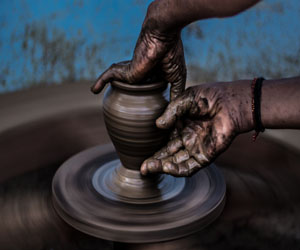
Traditional pottery, a craft rooted in centuries of human history, has a rich and enduring legacy that continues to captivate people with its authenticity and cultural significance. This art form, which varies from region to region, embodies the spirit of heritage, craftsmanship, and artistic expression. In this article, we will explore the world of traditional pottery, its history, techniques, and its enduring place in contemporary society.
A Journey Through History: The history of traditional pottery stretches back to the dawn of civilization. Archaeological findings reveal that pottery was an integral part of early human societies for practical purposes like cooking, storing food, and transporting water. It wasn't long before pottery began to evolve into an art form, with intricate designs and decorations that reflected the cultural identity of each community.
Techniques And Materials: Traditional pottery is characterized by a profound connection between the potter and the materials. Typically, it involves handbuilding techniques such as coiling, pinching, and slab-building, as well as the use of locally sourced clay and other natural materials. The techniques and materials used are often passed down through generations, preserving the authenticity and heritage of each style.
Regional Variations: One of the most compelling aspects of traditional pottery is its regional diversity. Different cultures have developed their own unique styles, forms, and designs. For example, the delicate blue and white porcelain of China is world-famous, while the intricately painted talavera ceramics of Mexico are celebrated for their vibrant patterns. Native American tribes have their distinctive pottery traditions, often incorporating symbolism and motifs reflecting their cultural heritage.
Cultural Significance: Traditional pottery is not just a craft; it is a reflection of cultural identity and history. Many traditional pottery forms have spiritual, ceremonial, or ritualistic importance within their respective cultures. In Native American Pueblo communities, for instance, pottery is often used in religious ceremonies, and the designs have deep cultural significance. In Japan, the tea ceremony is closely tied to the creation and appreciation of traditional pottery, such as the iconic Raku ware.
Preservation Of Craftsmanship: One of the most significant contributions of traditional pottery is its role in preserving craftsmanship. Potters who create traditional pottery often use age-old techniques that are passed down from master to apprentice. The continuation of these traditions ensures the perpetuation of valuable skills and techniques, safeguarding the art for future generations.
Contemporary Relevance: Traditional pottery remains highly relevant in today's world. While many traditional pottery pieces are still created for utilitarian purposes, such as cooking and storage, they also find their way into art galleries and collectors' homes. Traditional pottery artists often blend their inherited techniques with contemporary innovations, creating unique pieces that honor their heritage while appealing to modern sensibilities.
Traditional pottery is a testament to the enduring appeal of working with clay to create objects that are both functional and artistic. These age-old traditions connect us to our roots, telling the story of different cultures and their unique expressions of creativity. As we continue to appreciate and celebrate traditional pottery, we ensure that the spirit of this time-honored craft remains a vibrant part of our cultural heritage.
Decorating Your Herb Garden
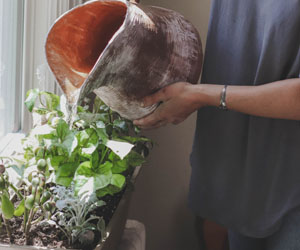 Symmetrical Or Geometric Layouts: Create symmetrical or geometric patterns in your garden, such as circular herb beds or rectangular planters. These structured designs can bring a sense of order and formality to your garden.
Symmetrical Or Geometric Layouts: Create symmetrical or geometric patterns in your garden, such as circular herb beds or rectangular planters. These structured designs can bring a sense of order and formality to your garden.
Herb Borders: Plant herbs along the edges of garden beds or walkways to define the space and create an organized, neat appearance.
Decorative Planters And Containers
Your choice of planters and containers can be a focal point in your herb garden:
Terracotta Pots: The rustic charm of terracotta pots adds a timeless elegance to your garden. Consider using pots of various sizes and shapes for a curated look.
Decorative Containers: Opt for unique and decorative containers like vintage crates, wooden barrels, or painted ceramics. These containers can be both functional and ornamental.
Hanging Baskets: Hang herbs in decorative baskets, allowing them to cascade gracefully. This not only saves space but also adds a touch of whimsy to your garden.
Vertical Planters: Vertical herb planters, such as living walls or pocket planters, are not only space-efficient but also create a captivating visual display.
Garden Decor And Art
Incorporating garden decor and art pieces can enhance the visual appeal of your herb garden:
Garden Statues: Statues, sculptures, or even ornamental birdbaths can be strategically placed to create a focal point or add a sense of character to your garden.
A Glimpse Into Monastery Brewing
 The Origins Of Monastery Brewing: The roots of monastic brewing can be traced back to medieval Europe, when monasteries were not only centers of spirituality but also hubs of agriculture and craftsmanship. Monks, skilled in cultivation and brewing, often brewed beer to support themselves and their communities. The monastic brewing tradition was born out of necessity and evolved into an art form celebrated for its unique and high-quality beers.
The Origins Of Monastery Brewing: The roots of monastic brewing can be traced back to medieval Europe, when monasteries were not only centers of spirituality but also hubs of agriculture and craftsmanship. Monks, skilled in cultivation and brewing, often brewed beer to support themselves and their communities. The monastic brewing tradition was born out of necessity and evolved into an art form celebrated for its unique and high-quality beers.
Brewing As A Form Of Self-Sufficiency: Monasteries were largely self-sustaining communities, and brewing became a valuable source of income for these religious orders. Monks brewed beer for their own consumption and to trade with neighboring communities. The high-quality beer produced within the monastery walls garnered a reputation for excellence and, over time, became an essential part of monastic life.
Brewing's Role In Monastic Life: For many monastic orders, brewing was not just a means of financial support; it was also deeply entwined with their way of life. Brewing was seen as a form of prayer, a means of connecting with the divine. Monks believed that by perfecting their brewing skills, they were glorifying God and serving their fellow humans through the creation of a sublime beverage.
A Universal Craft With Unique Flavors
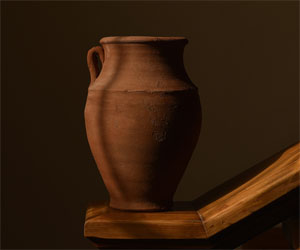 Asia: The Cradle Of Ceramic Art
Asia: The Cradle Of Ceramic Art
The roots of pottery in Asia run deep, with China often hailed as the birthplace of ceramics. Chinese pottery traditions date back thousands of years, and they have left an indelible mark on the global ceramic landscape. Iconic Chinese porcelain, known for its delicate blue and white designs, is world-renowned. Japanese pottery, on the other hand, is celebrated for its earthy, rustic aesthetics and meticulous craftsmanship. Countries like Korea, Thailand, and Vietnam have their unique ceramic traditions, showcasing the diversity within Asian pottery.
Africa: The Rhythms Of Clay
Across the African continent, pottery is both a functional and artistic tradition. The terracotta pottery of the Nok civilization in Nigeria, dating back to 1000 BC, represents some of the earliest ceramic artifacts in sub-Saharan Africa. In many African cultures, women are the primary potters, carrying on age-old traditions of coiling and hand-building. Each piece reflects the cultural values, motifs, and symbols of the community it hails from.
The Americas: Ancient Craftsmanship
In the Americas, pre-Columbian civilizations made remarkable contributions to pottery. The intricate designs and remarkable clay work of the Moche, Inca, and Maya peoples provide a window into the artistic and functional aspects of their societies. Native American tribes have their own distinctive styles, using clay to create pottery that is deeply rooted in their spiritual and cultural practices.
Europe: A Tapestry Of Styles
Europe boasts a rich tapestry of pottery traditions. The majolica pottery of Italy, famous for its colorful glazes and ornate patterns, showcases the Mediterranean region's artistry. The Delftware of the Netherlands is cherished for its blue and white hand-painted pottery.






Homemade Candle Recipes For DIY Enthusiasts
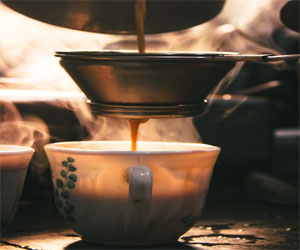 Materials:
Materials:
Wax (multiple colors for layering)
Wick
Fragrance oils (various scents)
Candle dye (multiple colors)
Heat-resistant container
Double boiler or microwave-safe bowl
Steps:
Prepare the container and wick as in the basic container candle recipe.
Melt each color of wax separately, adding specific fragrances and dyes.
Pour the first layer of wax into the container, allowing it to cool and solidify.
Repeat this process with different colors and scents, creating layered bands of wax.
Let the candle cool completely, trim the wick, and enjoy the fragrance and beautiful layers.
3. Upcycled Teacup Candle Recipe:
Materials:
Old teacup or small container
Wax
Wick
A Time-Honored Craft With Modern Relevance
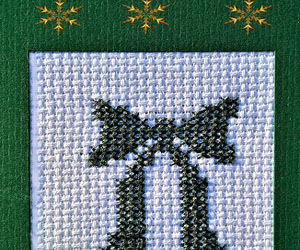 Connection To Tradition: Needlework connects us to our cultural heritage. Many techniques and patterns have been passed down through generations, preserving age-old traditions. This connection to tradition adds a layer of historical richness to the craft.
Connection To Tradition: Needlework connects us to our cultural heritage. Many techniques and patterns have been passed down through generations, preserving age-old traditions. This connection to tradition adds a layer of historical richness to the craft.
A Sustainable Hobby: Needlework is often sustainable and eco-friendly. Crafters can create practical, long-lasting items that reduce the need for disposable, mass-produced alternatives. This aspect of needlework aligns with a modern focus on sustainability and eco-conscious living.
Versatility: Needlework can take on various forms and serve diverse purposes. From functional items like clothing, home decor, and accessories to fine art and wall hangings, the versatility of needlework allows for a wide array of projects.
To explore the world of needlework and incorporate it into your life, consider the following steps:
Choose Your Craft: Start by selecting a specific form of needlework that resonates with you. Whether it's embroidery, cross-stitch, knitting, or crochet, choose a technique that aligns with your interests and goals.
Gather Materials: Acquire the necessary materials, such as fabric, thread, needles, and any other specific tools related to your chosen craft. High-quality materials can greatly enhance the final result.